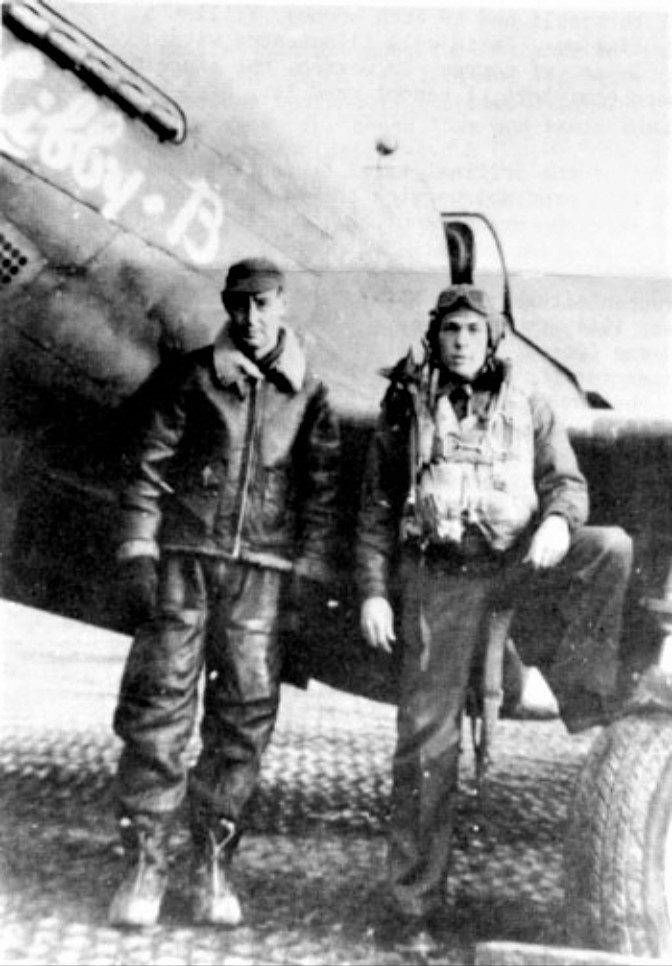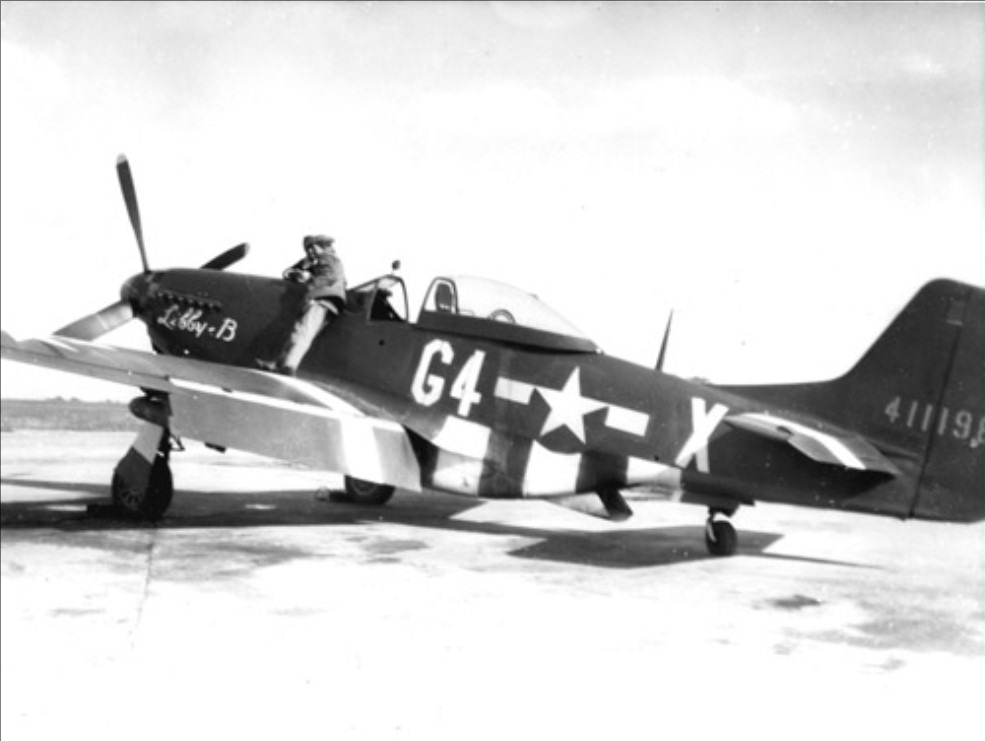
Crew Chief Robert Hall with Capt. William Mooney and his P-51 “Libby- B”, 44-11198, G4-X
Captain William H. Mooney Jr.
By Merle Olmsted, 357th FG Historian
It is Christmas Eve, 1944. The weather has been miserable all month. In the Ardennes Forest of Belgium, American Troops – short of winter clothing and everything else, have been fighting desperately for a week to stem Germany’s last massive attempt to change the course of the war. Their efforts will ultimately be successful – the powerful German offensive will fail.
The 8th Air Force is out in huge numbers (the largest of the war) to help the beleaguered ground troops, and so is the 357th FG. Col. Dregne and Major Peterson lead 75 P-51s, in two groups, off Leiston’s runways shortly before noon. The Luftwaffe is also out in force, and it will be an eventful Christmas Eve.
Before evening chow, the Mustangs have returned and it has been a good day with claims for 31 enemy fighters shot down. Statistically, the cost has been reasonable – 3 pilots failed to return, all three are dead. However, for those lost and their families and friends, it is not a reasonable statistic.
Among those lost is Lt. Wendall Helwig. He and his wingman Lt. Saul Sitzer flew thru a flight of 352nd Group P-51s. Sitzer was lucky, but Helwig flew broadside into one of the blue nose P-51s and both men died.
Lt. Don T. Gilbert shot down two FW 190s, and then, separated from Dollar Squadron, he engaged another 190. The two shot each other down, and both German and American died in unsuccessful bailouts.
Captain William H. Mooney Jr., along with Lt. Jesse Frey, were spares on the mission, and would not have had to fly the mission. Both continued however, flying above and behind Dollar Red Leader. Jesse Frey’s statement from the Missing Aircrew Report (MACR):
“Captain William H. Mooney Jr, 362nd FS, and I were flying Dollar spare, above and behind Dollar Red Leader. When the FW 190s were called in below us in the vicinity of Fulda, Germany, Capt. Mooney split-essed into the trailing gaggle of 190s. A 190 broke into him, but the 190 reversed his turn into another P-51. By this time I had lost Mooney. When I last saw him, he was tacked on to a FW 190. Several pilots of this squadron testify that they saw an olive drab P-51 of this unit on fire and saw it’s pilot bail out. Since Captain Mooney’s ship was painted this color, it was possibly he. All of the foregoing took place around 1425 B.S.T. on 24, December 1944.”
There are several translations of Luftwaffe documents with Mooney’s MACR, all of which indicate the aircraft was totally destroyed and the pilot dead. He was buried in the village cemetery of Laubach. There was no marker on the grave. As an unknown US soldier, the case was investigated postwar by a Quartermaster Grave Registration Company and this determined his identity. The final report was dated 5 August, 1947.
During the investigation, however, in August, 1945, the team obtained the following statement from the mayor of Laubach. “The pilot, unknown, made a crash landing and was then shot in the back by a man by the name of Hoffman, who is now in a prison camp in the vicinity of Marburg.
Although initially carried as an unknown by US authorities, several Luftwaffe reports dated 31 Dec, 1944, give his full name and service number. Whether they were aware of the circumstances of his death are unknown.
In the latter part of 1993, I was contacted by a Hans-Peter Koller of Offenbach, Germany. Koller was researching the death of Mooney, and asked for my assistance. In December of 1944, he had been a school boy about 11 years old and lived in the area where Moony landed. He had been a school mate of the son of Hoffman.
The results of Koller’s research were published in 1995 in the form of a small book titled “Der Fliegermard Von Freienseen.” Mr. Koller has kindly sent copies of the book to myself and to Arch Mooney, Williams’s brother, and a member of our association. It is well illustrated with photos and appears well done. It is, of course, in German, but since my knowledge of the language hovers near zero, I cannot read it. Arch promised a translation.
However, Koller sent a copy of the original trial transcript, which is of course, in English, and this provides us with the circumstances of the affair. We will quote here the evidence of the prosecution: (all references here to the accused refer to Emil Hoffman)
“The accused, and Ortsgruppenleiter in the NSDAP since 1933, arrested an American flyer, 24 December, 1944, at Freienseen, Germany. The American flyer was in the custody of Heene (Otto). After winning an argument with a German noncommissioned officer for the custody of the flyer, the accused left the flyer in the custody of Heene, while he returned to his home. Shortly thereafter the accused reappeared in his party uniform carrying a revolver in his hand. The accused and Heene together with another German then marched the flyer toward Jubach, Germany, where the flyer was to be turned over to the Kreisleiter’s office. Heene was on the left of the flyer and the accused was on the right. Suddenly the accused jumped up behind the flyer and fired a shot into him. The flyer staggered and the accused grabbed him by the arm and shot him again. The flyer fell to the ground. The accused returned to Freienseen, secured his horse and wagon, and returned to fetch the flyer to Lubach, where the victim was buried.”
“The pathologist’s report shows only two gunshot wounds in the victim’s body. The flyer at no time tried to escape on the way to Lubach.”
It is odd that nowhere in the trail papers I have is Mooney’s name mentioned. He is referred to only as a “flyer”, and for a time, he was unidentified. This may be the reason.
Heene and Hartman were both acquitted, but despite a skilled presentation by the defense (a US Army Captain Morse), Hoffman was convicted of the murder, and sentenced to be hanged. After the conviction, the defense again pleaded for clemency, referring to the fact that he had a family and no previous record. However, the conviction was upheld and Hoffman was executed at the Landsberg War Crimes Prison in August, 1944.
At the request of his father, William H. Mooney Sr, the remains were returned to the ZI in January 1945, to his home at Hawkinsville, Georgia, and then to the cemetery at Columbus, Georgia.
Mooney was the 2nd 357th FG pilot known to have been murdered by a German civilian, the first being Captain Fletcher Adams in May 1944.

P-51D Libby-B, G4-X

